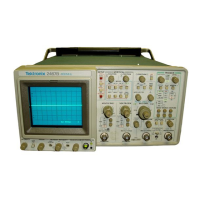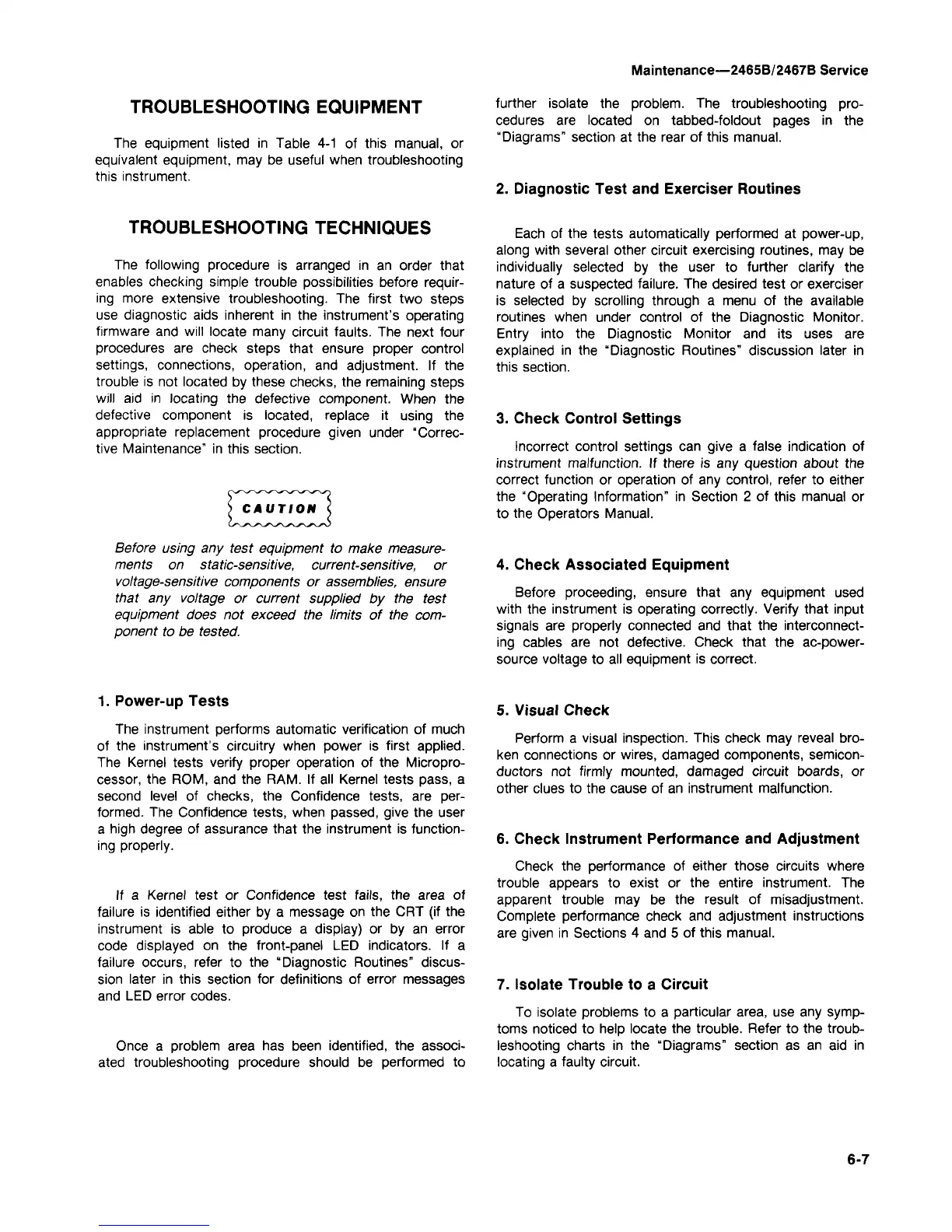Maintenance—2465B/2467B Service
TROUBLESHOOTING EQUIPMENT
The equipment listed in Table 4-1 of this manual, or
equivalent equipment, may be useful when troubleshooting
this instrument.
TROUBLESHOOTING TECHNIQUES
The following procedure is arranged in an order that
enables checking simple trouble possibilities before requir-
ing more extensive troubleshooting. The first two steps
use diagnostic aids inherent in the instrument's operating
firmware and will locate many circuit faults. The next four
procedures are check steps that ensure proper control
settings, connections, operation, and adjustment. If the
trouble is not located by these checks, the remaining steps
will aid in locating the defective component. When the
defective component is located, replace it using the
appropriate replacement procedure given under "Correc-
tive Maintenance" in this section.
Before using any test equipment to make measure-
ments on static-sensitive, current-sensitive, or
voltage-sensitive components or assemblies, ensure
that any voltage or current supplied by the test
equipment does not exceed the limits of the com-
ponent to be tested.
1.
Power-up Tests
The instrument performs automatic verification of much
of the instrument's circuitry when power is first applied.
The Kernel tests verify proper operation of the Micropro-
cessor, the ROM, and the RAM. If all Kernel tests pass, a
second level of checks, the Confidence tests, are per-
formed.
The Confidence tests, when passed, give the user
a high degree of assurance that the instrument is function-
ing properly.
If a Kernel test or Confidence test fails, the area of
failure is identified either by a message on the CRT (if the
instrument is able to produce a display) or by an error
code displayed on the front-panel LED indicators. If a
failure occurs, refer to the "Diagnostic Routines" discus-
sion later in this section for definitions of error messages
and LED error codes.
Once a problem area has been identified, the associ-
ated troubleshooting procedure should be performed to
further isolate the problem. The troubleshooting pro-
cedures are located on tabbed-foldout pages in the
"Diagrams" section at the rear of this manual.
2.
Diagnostic Test and Exerciser Routines
Each of the tests automatically performed at power-up,
along with several other circuit exercising routines, may be
individually selected by the user to further clarify the
nature of a suspected failure. The desired test or exerciser
is selected by scrolling through a menu of the available
routines when under control of the Diagnostic Monitor.
Entry into the Diagnostic Monitor and its uses are
explained in the "Diagnostic Routines" discussion later in
this section.
3. Check Control Settings
Incorrect control settings can give a false indication of
instrument malfunction. If there is any question about the
correct function or operation of any control, refer to either
the "Operating Information" in Section 2 of this manual or
to the Operators Manual.
4. Check Associated Equipment
Before proceeding, ensure that any equipment used
with the instrument is operating correctly. Verify that input
signals are properly connected and that the interconnect-
ing cables are not defective. Check that the ac-power-
source voltage to all equipment is correct.
5. Visual Check
Perform a visual inspection. This check may reveal bro-
ken connections or wires, damaged components, semicon-
ductors not firmly mounted, damaged circuit boards, or
other clues to the cause of an instrument malfunction.
6. Check Instrument Performance and Adjustment
Check the performance of either those circuits where
trouble appears to exist or the entire instrument. The
apparent trouble may be the result of misadjustment.
Complete performance check and adjustment instructions
are given in Sections 4 and 5 of this manual.
7. Isolate Trouble to a Circuit
To isolate problems to a particular area, use any symp-
toms noticed to help locate the trouble. Refer to the troub-
leshooting charts in the "Diagrams" section as an aid in
locating a faulty circuit.
6-7

